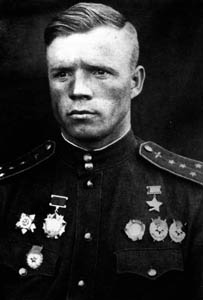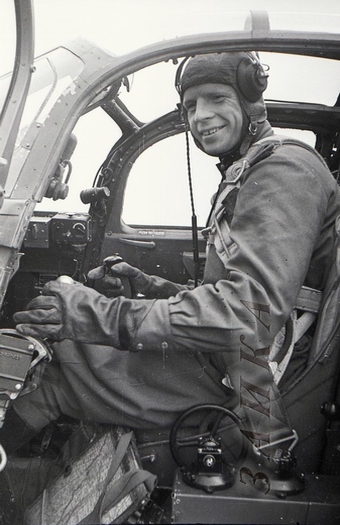Soviet Union

Kapitan Aleksandr Fedorovich Klubov HSU
Soviet Union

Kapitan Aleksandr Fedorovich Klubov HSU

18 January 1918 – 1 November 1944
Klubov was born on 18 January 1918 in Jarunovo in the Vologda area.
He learned to fly in an aeroclub before joining the VVS in 1939 and completed his flying training at Chuguevskuju military flying school the following year.
He was stationed in Leningrad in June 1941 but did not see any action before he was posted to the 10 IAP flying I-153s.
He flew his first combat mission on 28 July 1941 but was then badly wounded and out of action for several months.
Mladshiy leitenant Klubov was posted to the 84-A IAP in August 1942. This unit was formed on 6 August 1942 with 16 I-153s and flew from Mozdok, North Caucasus, on the Caucasian Front. The unit was mainly used for ground attack missions. During 4 ½ month they shot and strafed 122 German aircraft on the ground, destroyed 319 tanks, 1087 trucks, 24 guns, 222 Flaks and machine-gun Flaks. Of these were 40 cars and 15 Flaks claimed by Klubov on 153 ground-attack missions (by early November 1942).
Around midday on 4 September, kapitan Petr Sereda, CO of the 84-A IAP, led his I-153s in a low-level attack against the Terek bridges in the Lukovskaya area. Defying the intense ground fire, the I-153s carried out several gunnery runs against the target. Leitenant Klubov, managed to set some of German 111th Infantry Division’s trucks ablaze.
The formation was intercepted by Bf 109s from III/JG 52 (including Oberfeldwebel Alfred Grislawski) but the biplanes managed to evade all German attacks until the Soviet escort of I-16s from 88 IAP intervened. Grislawksi shot down one I-16 at 11:29 but two Bf 109s were lost in the combat. It seems that Klubov is credited with one Bf 109 in this combat.
He claimed a Bf 110 on 31 October.
On 2 November 1942, 84-A IAP I-153s, escorted by I-16s from 88 IAP, were carrying out low-level attacks against a German army position east of Gisel. They were attacked by a Rotte of Bf 109s from 7./JG 52 led by Oberfeldwebel Alfred Grislawski. Grislawski quickly shot down an I-16 (victory no. 61 of a total of 132) flown by Serzhant Vladimir Yudin, which crashed to his death. Then Grislawski turned against one of the biplanes at treetop level. The combat was drawn out before Grislawski got the I-153 in his gun sight. He opened fire and the biplane caught fire (victory no. 62). The I-153 was flown by starshiy leitenant Klubov, who reportedly hit a Bf 109 before he was hit by the Germans wingman. His aircraft caught fire and the flames swept from the engine to the cockpit. Klubov hastened to land his burning aircraft and below he could see a field. The flames were already licking his face and he pushed the stick forward and touched down on the ground. Soldiers came running to the aircraft, which was blazing like a torch. They pulled the tormented pilot out of his flaming captivity before the aircraft burned down.
Klubov was seriously burned and his face bore the scars of this incident for the rest of his life.
Grislawski saw the I-153 go up in flames on the ground below at 11:40 (the previous victory was claimed at 11:38) before turning home to celebrate his 23rd birthday.
It seems that the Soviet aircraft claimed two Bf 109s as shared among four pilots, including Klubov. No German aircraft was lost in this combat.
With his tally standing at 3 aerial victories plus 16 more destroyed on the ground during 150 sorties, in late May 1943 he was assigned to the 16 GIAP equipped with the P-39 Airacobra when the most experienced pilots from the 84-A IAP was transferred to this unit.
Under the tutelage of Aleksandr Pokryshkin he would run up a large score in a series of hard battles over Taman, Rostov and Novocherkassk requiring only 68 sorties and 28 combats to run his score to 14 in three months combat including 4 and 19 shared over the Kuban River.

One of his victims was a Bf 109 that he forced down over north-west Moldavia on 23 July 1943.
On 16 August, his flight of six Airacobras found two FW 189s with four Bf 109s as escort. Splitting his force to attack from both sides, Klubov and his pilots downed both FW 189s, one of them credited to Klubov, for no losses.
The Airacobras from 16 GIAP fought with Bf 109s north of Lyubimovka on 28 September 1943. One of these were claimed by Klubov while a second was claimed by leitenant Nikolay Chistov.
On an unrecorded date, he almost fell foul of a Messerschmitt whose pilot was his equal in every respect but finally managed to shake him off and turned for home to crash-land his crippled Airacobra on his own airfield.
He frequently flew an olive drab/neutral grey P-39N "White 45" with a red spinner.
On 13 April 1944, he was decorated with the Gold Star of Hero of the Soviet Union (# 1320) and the Order of Lenin for 14 and 3 fractional victories on 84 air combats on 310 sorties as of September 1943.
It is reputed that during this period one of the other pilots in his unit was killed in a crash, occasioned by a spanner having been left loose in the aircraft. At a party to mourn the man's death, Klubov killed the mechanic responsible. As a consequence, he was stripped of his decorations, but was permitted to continue flying.
He was then involved in operations over the Sea of Azov and the Crimea.
He subsequently flew on the 4th Ukrainian Front during the Yassy-Kishinev operations and his actions were considered to have redeemed him, and his decorations were reinstated.
He quickly rose to kapitan and in May 1944, he was an eskadrilya leader and deputy regiment commander.
On 30 May, his flight met nine Ju 87s escorted by ten Bf 109s, and Klubov downed the leader of the Stuka formation, thus disrupting the attack. His own aircraft was damaged by one of the Bf 109s, however, and he only just made it back to base.
In mid-June 1944, the unit was transferred to the 1st Ukrainian Front for the Lvov-Sandomierz operation.
Klubov then participated in periods of intense activity during the Lemberg-Sandomierz campaign (13 July - 29 August 1944).
He claimed two Ju 87s on 16 July while leading 12 Airacobras on a front-line patrol.
Between 10:00 and 10:45 on 25 August, he flew a sortie together with his wingman mladishiy leitenant Sergey Ivanov between Sandomoir, Lagun, Keltse, Mologosh and Khmelnik. They spotted a lone enemy fighter at 13,125 feet in the Keltse area. The two Soviet fighters immediately slipped into the clouds and took a closing course with the enemy fighter. They did not rush their approach, carefully masking themselves with clouds and overcast.
Klubov guided Ivanov into an attack on the enemy fighter and the wingman struck from the front at an angle. The enemy fighter flashed by underneath the Airacobra. It turned out that it was a Bf 110 and the rear gunner opened fire. The Soviet fighters’ first attack was a failure and Klubov radioed Ivanov that he should attack from the left and right rear. Klubov hit the gunner’s compartment with a long burst from 110 to 85 yards and the now dead gunner ceased firing. Ivanov hit the engines, setting them on fire. The Bf 110 began slowly rotating to the right, presenting its entire underbelly to the P-39s and Klubov finished off it with a second pass. Ivanov attacked the Bf 110 a third time, delivering the coup de grace and seconds later it crashed into the earth.
The returning pilots shared the monetary bonus for the destruction of a fighter (1000 rubles in the closing period of the war) even if seems that it was credited to Klubov.
This sortie had been a radar (RUS-2) led interception.
On 6 October 1944 the president of the Bell firm (USA) awarded engraved watches with congratulatory letters signed in English to guards polkovnik A. I. Pokryskhin, guards major D. B. Glinka, guards kapitan Grigoriy Rechkalov, guards major B. B. Glinka, guards Mayor K. G. Vishnevetskiy, guards kapitan Klubov, guards starshiy leitenant I. I. Babak, guards starshiy leitenant A. I. Trud and guards kapitan M. S. Komelkov.
These pilots all had shot down twenty or more enemy aircraft as of 24 June 1944 while flying the Airacobra and were all decorated with the Gold Star of the Hero of the Soviet Union (Pokryskhin three times, D. B. Glinka and Grigoriy Rechkalov twice).
The watches were presented to the pilots by the commander of the 2nd Air Army, general Stepan Krasovskiy. Major Vishnevetskiy received his watch posthumously since he was killed on 30 July 1944 in an enemy air raid.
After the death of Aleksandr Pokryskhin in 1985, his widow Maria placed his “Bell” watch in the Central Museum of the Soviet (now Russian) Army in Moscow, where it remains on display to this day.
In October, Klubov served as deputy commander for aerial gunnery of the 16 GIAP.
On 1 November, kapitan Klubov was flying a training flight in one of the new Lavochkin La-7s. While landing he didn’t fully extend the flaps and the aircraft careened past the end of the runway due to excessive speed. When one of its wheels dug into soft dirt, it flipped over and broke up. The entire incident occurred in full view of many of Klubov’s comrades, which rushed to his aid, but his life couldn’t be saved.
Klubov was buried in Lvov on the Hill of Glory.
Klubov was admired and highly respected by his comrades. G. Golubev, a fellow 16 IAP aces, provides the following recollection:
"He was a cool and calculating leader, aggressive in the air, fast surprise attacks were his forte. He possessed a remarkable physique and stamina that combined with his great fighting spirit. He neither knew fear nor did he waver in the face of numerical enemy superiority. To take off on a mission with Klubov almost invariably meant success."On 27 June 1945, he was posthumously decorated with a second Gold Star of Hero of the Soviet Union for 31 victories in 95 air combats on 457 sorties as of October 1944.
Klubov was also decorated with the Order of the Red Banner (on 10 October 1942 and 4 November 1943), the Order of Aleksandr Nievsky (2 February 1944) and then Order of the Patriotic War 1st Class (2 May 1943).
At the time of his death Klubov he was credited with 3 biplane victories and a total of 31. These were claimed in 95 encounters on 457 sorties. He was also credited with at least 16 aircraft destroyed on the ground.
Claims:
| Kill no. | Date | Time | Number | Type | Result | Plane type | Serial no. | Locality | Unit |
| 1942 | |||||||||
| 1 | 19/08/42 | 1 | Bf 109 | Destroyed | I-153 | NW Chernihiv | 84-A IAP | ||
| 2 | 04/09/42 | a.m. | 1 | Bf 109 | Destroyed | I-153 | Predmostnyj | 84-A IAP | |
| 29/09/42 | 1 | Bf 109 | Shared destroyed | I-153 | 84-A IAP | ||||
| 3 | 31/10/42 | 1 | Bf 110 | Destroyed | I-153 | 84-A IAP | |||
| 02/11/42 | a.m. | 1 | Bf 109 (a) | Shared destroyed | I-153 | E Gisel | 84-A IAP | ||
| 02/11/42 | a.m. | 1 | Bf 109 (a) | Shared destroyed | I-153 | E Gisel | 84-A IAP | ||
| 1943 | |||||||||
| 4 | 23/07/43 | 1 | Bf 109 | Destroyed | Airacobra | NW Moldavia | 16 GIAP | ||
| 5 | 16/08/43 | 1 | FW 189 | Destroyed | Airacobra | Kamenka | 16 GIAP | ||
| 6 | 26/08/43 | 1 | Bf 109 | Destroyed | Airacobra | SW Kolpakova | 16 GIAP | ||
| 7 | 30/08/43 | 1 | Ju 88 | Destroyed | Airacobra | Malo-Kirsanovka | 16 GIAP | ||
| 8 | 30/08/43 | 1 | Ju 88 | Destroyed | Airacobra | Malo-Kirsanovka | 16 GIAP | ||
| 9 | 30/08/43 | 1 | Ju 87 | Destroyed | Airacobra | S Novo-Khreschatyk | 16 GIAP | ||
| 10 | 31/08/43 | 1 | Bf 109 | Destroyed | Airacobra | 16 GIAP | |||
| 11 | 31/08/43 | 1 | Hs 129 | Destroyed | Airacobra | S Anastasievka | 16 GIAP | ||
| 12 | 31/08/43 | 1 | Hs 129 | Destroyed | Airacobra | Anastasievka | 16 GIAP | ||
| 13 | 02/09/43 | 1 | Bf 109 | Destroyed | Airacobra | Kalinin | 16 GIAP | ||
| 14 | 19/09/43 | 1 | Bf 109 | Destroyed | Airacobra | S Novo-Filippovka | 16 GIAP | ||
| 15 | 26/09/43 | 1 | He 111 | Destroyed | Airacobra | Dnieper River | 16 GIAP | ||
| 16 | 28/09/43 | 1 | Bf 109 | Destroyed | Airacobra | N Lyubimovka | 16 GIAP | ||
| 17 | 01/11/43 | 1 | Ju 87 | Destroyed | Airacobra | N Armyansk | 16 GIAP | ||
| 18 | 01/11/43 | 1 | Ju 87 | Destroyed | Airacobra | N Budennovka | 16 GIAP | ||
| 1944 | |||||||||
| 19 | 30/05/44 | 1 | Ju 87 | Destroyed | Airacobra | N Iasi | 16 GIAP | ||
| 20 | 30/05/44 | 1 | FW 190 | Destroyed | Airacobra | Iasi | 16 GIAP | ||
| 21 | 30/05/44 | 1 | FW 190 | Destroyed | Airacobra | Galata | 16 GIAP | ||
| 22 | 30/05/44 | 1 | Ju 87 | Destroyed | Airacobra | NE Iasi | 16 GIAP | ||
| 23 | 31/05/44 | 1 | Ju 87 | Destroyed | Airacobra | Rediu | 16 GIAP | ||
| 24 | 31/05/44 | 1 | Ju 87 | Destroyed | Airacobra | Rediu | 16 GIAP | ||
| 25 | 03/06/44 | 1 | Bf 109 | Destroyed | Airacobra | S Epureni | 16 GIAP | ||
| 26 | 04/06/44 | 1 | Ju 88 | Destroyed | Airacobra | S Epureni | 16 GIAP | ||
| 27 | 04/06/44 | 1 | Bf 109 | Destroyed | Airacobra | Rediu | 16 GIAP | ||
| 28 | 16/07/44 | 1 | Ju 87 | Destroyed | Airacobra | Sushno | 16 GIAP | ||
| 29 | 16/07/44 | 1 | Ju 87 | Destroyed | Airacobra | Sushno | 16 GIAP | ||
| 30 | 16/07/44 | 1 | FW 190 | Destroyed | Airacobra | Sushno | 16 GIAP | ||
| 31 | 25/08/44 | 10:00-10:45 | 1 | Bf 110 | Destroyed | Airacobra | E Mologosh | 16 GIAP |
Biplane victories: 3 and 3 shared destroyed, 16 aircraft, 40 cars and 15 Flaks destroyed on the ground.
TOTAL: 31 and 3 shared destroyed, 3 damaged, 16 aircraft, 40 cars and 15 Flaks destroyed on the ground.
(a) Claimed in combat with a Rotte of 7./JG 52, which didn’t suffer any losses.
Sources:
All aces of Stalin 1936–1953 – Mikhail Bykov, 2014
Attack of the Airacobras - Dmitriy Loza, 2002 University Press of Kansas, ISBN 0-7006-1140-1
Black Cross/Red Star Volume III - Christer Bergström, Andrey Dikov and Vlad Antipov, 2006 Eagle Editions Ltd, Hamilton, ISBN 0-9761034-4-3
Graf & Grislawski: A Pair Of Aces - Christer Bergström with Vlad Antipov and Claes Sundin, 2003 Eagle Editions Ltd., Hamilton, USA, ISBN 0-9721060-4-9
Luftwaffe Claims Lists - Tony Wood
P-39 Airacobra Aces of the World War 2 - George Mellinger and John Stanaway, 2001 Osprey Publishing, Oxford, ISBN 1-84176-204-0
Sovetskiye asy - Nikolay Bodrikhin, 1998 kindly provided by Ondrej Repka.
Soviet Aces 1936-1953
Soviet Fighter Pilots 1936-1953 - Mikhail Bykov
Soviet Lend-Lease Fighter Aces of World War 2 - George Mellinger, 2006 Osprey Publishing Limited, Oxford, ISBN 1-84603-041-2
Stalin's Eagles - Hans D. Seidl, 1998 Schiffer Publishing, ISBN 0-7643-0476-3
Stalin's Falcons - Tomas Polak and Christhoper Shores, 1999 Grub Street, London, ISBN 1-902304-01-2
Eskadrilia vediot boi - K. Suhov, 1983 kindly provided by Alexey V. Andreev.
Additional information kindly provided by Vladislav Arhipov.


